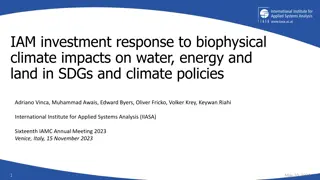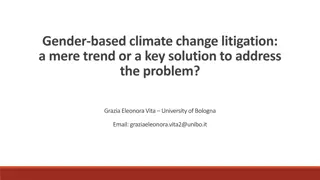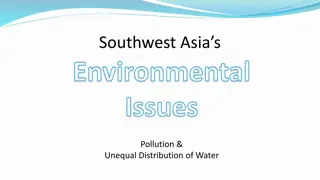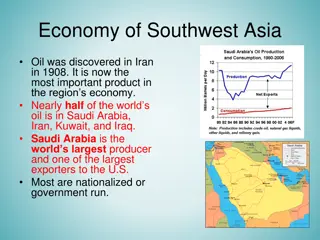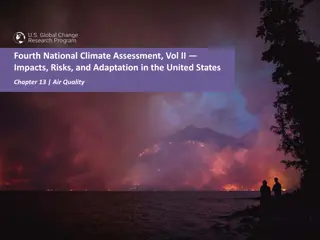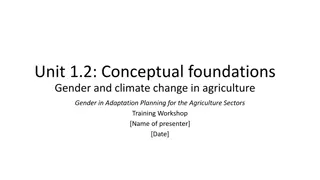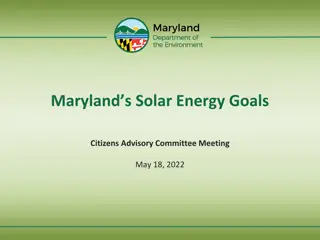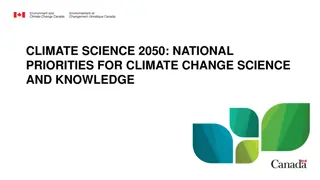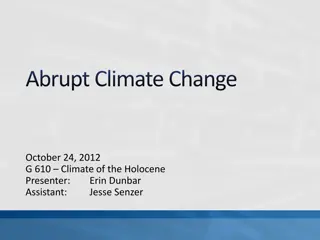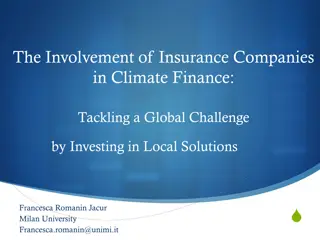
Impacts of Climate Change on Southwest Asia
The UNFCCC IPCC report highlights the urgent need for significant reductions in greenhouse gas emissions to limit global warming to 1.5°C. A study in Nature Climate Change warns of extreme heat events in Southwest Asia, with temperatures projected to rise above human adaptability thresholds. Urgent action is required to combat climate change and avoid severe impacts on human habitability in the region.
Download Presentation

Please find below an Image/Link to download the presentation.
The content on the website is provided AS IS for your information and personal use only. It may not be sold, licensed, or shared on other websites without obtaining consent from the author. If you encounter any issues during the download, it is possible that the publisher has removed the file from their server.
You are allowed to download the files provided on this website for personal or commercial use, subject to the condition that they are used lawfully. All files are the property of their respective owners.
The content on the website is provided AS IS for your information and personal use only. It may not be sold, licensed, or shared on other websites without obtaining consent from the author.
E N D
Presentation Transcript
JEAN MONNET MODULE DOHA COURSES ON EUROPEAN UNION LAW FALL 2021 DR. JON TRUBY
COMBATING CLIMATE CHANGE
UNFCCC IPCC REPORT 2021 The report identifies that the level of future emissions will determine the level of future temperature rise and the severity of future climate change and the associated impacts and risks. Not only have CO2 concentrations increased in the Earth s atmosphere, but the rate of the increase has also sped up. The report shows that greenhouse gas emissions from human activities are responsible for approximately 1.1 C of warming since 1850-1900, and finds that averaged over the next 20 years, global temperature is expected to reach or exceed 1.5 C of warming. Unless there are rapid, sustained and large-scale reductions of climate change-causing greenhouse gas emissions, including CO2, methane and others, the goal of limiting global warming to 1.5C compared to pre-industrial levels, as enshrined in the Paris Agreement, will be beyond reach.
FUTURE TEMPERATURE IN SOUTHWEST ASIA PROJECTED TO EXCEED A THRESHOLD FOR HUMAN ADAPTABILITY: 4 DEGREES MIT research in the journal Nature Climate Change. In places such as Abu Dhabi and Doha, by 2070 the hottest days of today would be a near-daily occurrence sometimes 60C in Kuwait City Water scarcity to become constant Our results expose a specific regional hotspot where climate change, in the absence of significant [carbon cuts], is likely to severely impact human habitability in the future, said Prof Jeremy Pal and Prof Elfatih Eltahir research also showed that cutting greenhouse gas emissions now could avoid this fate The new research examined how a combined measure of temperature and humidity, called wet bulb temperature (WBT), would increase if carbon emissions continue on current trends and the world warms by 4C this century. http://www.nature.com/articles/nclimate2833.epdf?referrer_access_token=Ec8k4K-mDQg6g747Wy2GN9RgN0jAjWel9jnR3ZoTv0OZpZnipSID05z1sMtFpyQJIBXPEiHECZySbcPV- XkFfp_vEjYsmT_XeeSgyGMjuxeRHStLOL_UJJLAa_6FXeBEd5irdd5ZWvYtXFMHrLnjuDneyQZYDt06Em1V8caY- jKueRMSqOhJMuE0YyNcqZu4gk1AyZy8iwbmblox3UfRCvYOuge87p6edwd3sg13UIjs3ljLGA4DB8QxETUcqURM0y6R2A6BuQLrDzlGgsonlw1Jp-AyVI6Srav8jRU0aZw%3D&tracking_referrer=www.theguardian.com
General Information By 2018, the EU had cut GHG emissions by 23% compared to 1990 levels, and it is committed to achieving a 40% cut by 2030. In December 2019, the European Commission presented the European Green Deal. Is now proposing a package of measures aimed at increasing its GHG emission reduction ambition for 2030 and decarbonising the EU s economy by 2050, in line with the Paris Agreement. In September 2020 the Commission proposed to raise the climate ambition of the GHG emission reduction target to 55% by 2030 compared to 1990 levels.
Goals By means of its 2030 climate and energy framework, the EU has committed itself to the following goals, to be reached by 2030: 1. Reducing GHG emissions by at least 40% below 1990 levels; 2. Improving energy efficiency by 32.5%; 3. Increasing the share of renewable energy sources to 32% of final consumption.
Goals The 2030 framework comes as a follow-up to the 20-20-20 targets decided on in 2007 by EU leaders for 2020: 1. 20% reduction in GHG emissions; 2. 20% increase in the share of renewable energy in final energy consumption; 3. 20% reduction in total EU primary energy consumption (all compared with 1990). All translated into binding legislative measures.
EU Emissions Trading System (ETS) The EU ETS, the first and still the largest international carbon market, is a key EU policy instrument for fighting climate change. It is based on the cap and trade principle: - A cap is set on the total amount of GHG emissions that can be emitted by the more than 11 000 installations (factories, power stations, etc.) included in the scheme. Each installation buys or receives emission allowances auctioned by the Member States. These credits corresponding to one tonne of CO2 each can be traded with other installations if unused.
EU ETS Over time, the overall amount of allowances is progressively reduced. Two funds a modernisation fund and an innovation fund will help to upgrade energy systems in lower-income Member States and foster innovation by funding renewable energy, carbon capture and storage (CCS) and low-carbon projects. Aviation emissions are also covered by the ETS, although the current exemption for intercontinental flights has been extended until the end of 2023, when the first phase of the International Civil Aviation Organisation s (ICAO) Carbon Reduction and Offsetting Scheme for International Aviation (CORSIA) is set to begin.
EU ETS Emissions from sectors not covered by the ETS, such as road transport, waste, agriculture and buildings, are subject to binding annual GHG emission reduction targets for each Member State. In a recent update, Parliament and the Council agreed on minimum targets for 2021-2030 to help reach the EU s goal of a 30% GHG reduction from these sectors compared to 2005 and to contribute to the achievement of the objectives of the ParisAgreement. For the first time, each Member State will have to ensure that emissions from land use, land use change and forestry (LULUCF) do not exceed removals.
Renewable Energy Directive (RE) The RE Directive seeks to ensure that by 2030 renewable energy such as solar power, wind, hydroelectric power and biomass will make up at least 32% of the EU s total energy consumption in terms of electricity generation, transport, heating and cooling. Each Member State adopts its own national renewable energy action plan, including sectoral targets. In order to mainstream the use of renewable energy in the transport sector, Member States must set an obligation on fuel suppliers to ensure that the share of renewable energy within the final energy consumption of the transport sector is at least 14% by 2030.
Revised Directive on Energy Efficiency The revised Directive on Energy Efficiency sets an energy efficiency target of 32.5% for the EU by 2030, with a clause for upward revision by 2023. It also extends the annual energy saving obligation beyond 2020. In addition, the revised Directive on Energy Performance in Buildings was adopted in May 2018. This includes measures that will accelerate the rate of building renovation and the move towards more energy-efficient systems, and improve the energy performance of new buildings, with the use of intelligent energy management systems.
Governance Regulation It implements a transparent governance process to track progress towards the objectives of the EU Energy Union and Climate Action. Member States are obliged to adopt integrated National Climate and Energy Plans (NECPs) for the 2021-2030 period. In September 2020, the Commission took stock of the final NECPs and confirmed that they are largely consistent with the Union s 2030 targets with the exemption of energy efficiency. The governance process also provides an opportunity to update the plans every two years to reflect experience and to take advantage of new opportunities for the remainder of the decade.
Carbon Capture and Storage Carbon capture and storage (CCS) technology separates CO2 from atmospheric emissions (resulting from industrial processes), compresses the CO2, and transports it to a location where it can be stored. According to the IPCC, CCS could remove 80-90% of CO2 emissions from fossil fuel-burning power plants. However, the implementation of the envisaged demonstration projects in Europe has proven more difficult than initially foreseen, high costs being one of the main barriers.
CO2 Emissions Standards New passenger cars registered in the EU have to comply with CO2 emissions standards. The target to be reached by car fleets is an average of 130g of CO2/km for 2015 and will be reduced to 95g/km as from 2021. In order to create incentives for industry to invest in new technologies, so-called super-credits can be used, whereby the cleanest cars in each manufacturer s range count as more than one car when calculating the average specific CO2 emissions. Asimilar regulation is in place for vans.
Fuel Quality Fuel quality is also an important element for GHG emission reductions. EU legislation aims to reduce the GHG intensity of fuels by 6% by 2020. this is to be achieved by, among other measures, the use of biofuels, which must, however, meet certain sustainability criteria.
Union-wide System for the Monitoring, Reporting and Verification (MRV) of CO2 Emissions from Ships CO2 emissions from international maritime shipping are significant, and are expected to grow considerably. While pressing for a global approach, the EU has established a Union-wide system for the monitoring, reporting and verification (MRV) of CO2 emissions from ships, as a first step towards cutting them. Large ships have to monitor and annually report their verified CO2 emissions released on their way to and from EU ports and within those ports, along with other relevant information.
Measures to Control the Use of Fluorinated Gases Following bans on chlorofluorocarbons (CFCs) in the 1980s to stop the depletion of the ozone layer, fluorinated gases are used as substitutes in a range of industrial applications such as air conditioning and refrigeration, since they do not harm the ozone layer. However, they may have a global warming potential of up to 23 000 times that of CO2. The EU has therefore taken measures to control the use of fluorinated gases and ban their use in new air conditioning appliances and refrigerators by 2022-2025, thereby setting the pace for a global phase-out.
The European Green Deal On 11 December 2019, the Commission presented the European Green Deal, an ambitious package of intended measures designed to enable the EU to become carbon neutral by 2050. The measures, which are accompanied by an initial roadmap of key policies, range from ambitious cuts to emissions, to investing in cutting-edge research and innovation, to preserving Europe s natural environment. Supported by investments in green technologies, sustainable solutions and new businesses, the Green Deal aims also to be a new EU growth strategy.
The European Green Deal The involvement and commitment of the public and of all stakeholders is crucial to its success. Above all, the European Green Deal sets a path for a transition that is just and socially fair. At the European Council of 12 December 2019, all Member States adopted the target of making the EU carbon neutral by 2050 with the exception of Poland which, although supporting the 2050 goal, was unable to commit to implementing the objective.
The European Green Deal The European Green Deal provides an action plan to transform the EU into a sustainable and competitive economy. Among the measures proposed is the European Climate Law to ensure a climate-neutral EU by 2050. In particular, it makes provision for increasing the 2030 target to cut GHG emissions to at least 55%. The Commission s proposals in 2020 included a communication on the Sustainable Europe Investment Plan, a proposal for a regulation establishing the Just Transition Fund, EU strategies for energy system integration and for hydrogen, and, in October, a communication on how to reduce methane emissions.





